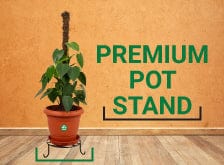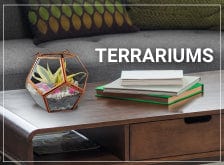How to Grow
4 easy steps to grow Coriander at home
Coriander is a herbaceous annual plant. There is no food which is prepared in the Indian culinary without coriander or cilantro. Their fresh leaves, stems and dry seeds are used as herbs and spices all over the world. Both leaves and stems of coriander have pungent flavor. Coriander grows within 40-45 days after sowing of seeds. Being spice and herb it is loaded with many health benefits from keeping your skin healthy to reducing risks of heart problems.
Botanical information
Botanical Name: Coriandrum sativum
Family: Apiaceae
Common names: Coriander, Cilantro, Dhaniya,
Centre of origin: Mediterranean region
Growing coriander in pots at home
We use Coriander leaves to flavor our food which is a wonderful source of various nutrients, vitamins, and minerals. Addition of fresh coriander leaves makes your food healthy, spicy and gives perfect taste. Grow coriander plants from coriander seeds in your garden. Decorate your food with fresh coriander leaves.
Following are the 4 steps to grow coriander plants in pots or in your garden.

Step 1: Choose the best time to plant
It is a plant that grows best in the sun. But too much of heat during summer will also be negative, so keep the plants positioning to get the shade during the high temperature. They won’t survive in cold weather but it does not like extreme heat either. The best time to start planting is in between the months of March and May.

Step 2: Choose either pot or your garden to plant Coriander seeds
You can either grow it in a pot or in your garden.
If you want to grow in a pot then choose one which is 18 inches wide and at least 10-12 inches deep.
If you want to plant in a garden then choose the best place where you find the organic soil with enriched nutrients.
Each round seed is technically a fruit which contains two seeds as shown in the picture. Each seed will grow as an individual plant.

You can sow whole seed or you can split and sown. If you split and sow seeds, it will increase the germination rate.
Sow seeds 3-4 inches apart and 1/2 inch deep into the soil.
Keep the soil moist by spraying the water until seedlings germinate but do not over water it.
Maintain at least 6-8 inches space between two seeds, otherwise, it may invite pests and diseases due to overcrowding.

Step 3: Germination of coriander seeds
Coriander will start to germinate in about 2 to 3 weeks. It requires plenty of moisture to germinate, so make sure to water them frequently also ensure that they get a good amount of sunlight.

Care for Germinated plants
- Water them frequently so that soil never dries out. But do not over water it.
- Make sure they get good sunlight. In case of high temperature, provide the plants with shade or keep the pots inside.
-
Keep the soil rich in organic matter. You can add fertilizers like potting mix or compost if you wish to.
Step 4: Harvest the Coriander plants
When the plants reach about 6 inches tall, it’s the time to harvest your plants. Usually, it takes 45 to 60 days to harvest. Harvest the leaves and stems from the base of the plants using Pruning Secateurs or by hand.
Use fresh green leaves in your food. Avoid older or yellow colored leaves which may taste bitter.
Also note, not to harvest more than one-third of the plants as it may weaken the plants.
Once you have done with the harvesting of leaves, the plants will continue to grow for two to three more cycles.
Keep harvesting the fresh leaves.

How to grow coriander from store brought coriander:
- Take healthy coriander stems that have roots.
- Cut the stems leaving 2 inches of stems above the origin of the roots.
- Plant these stems in any fertile organic potting mix at 3-4 inches apart.
- Use well drained soil to plant coriander stems as clay soil retains water for long time and result in root rots.
- Water them thoroughly after planting. Thereafter water them when the top inch of soil becomes slightly dry.
- Water plays a major role in keeping these coriander stems alive because it is the only source that allows them to intake nutrients. Leaving the soil dry between watering may damage the cutting as they do not have any leaves to supply food by performing photosynthesis.
- Stems may become dry but you will notice the new growth within 7-14 days of planting.
How to grow coriander for seeds:
When you grow coriander to harvest seeds, you need to wait some more days until the plants flower, set seeds. When the green seeds turn yellow- brown, you can harvest the seeds from them. It takes around 90-110 days from seeds to harvest. Meanwhile water them regularly and add any organic fertilizers for every 20 days right from flowering to harvesting. Fertilizing helps in boosting the flowering and seed setting in coriander plants. Follow these care tips if you intend to harvest coriander seeds.
Decide whether to leave the plants to flower or not
Your plants may start to flower (Bolting) sooner or later. At this point, the plants will stop to produce fresh leaves. Now it’s your choice to leave the plants to flower or not.
However, if you want to harvest coriander seeds from your plants then you can leave it to flower. Once the flower dries, you will be able to harvest seeds. Either you can use the harvested seeds to cook or save the seeds to plant for the next season.
Alternatively, you can allow the seeds directly to fall into the ground which can make self-sow, and provide you with more plants.
Bolting:
Bolting is a natural process of plants when they start to flower. While growing they start to bolt when they go through stress. The stress can come in different ways. It could be the following reasons.
- High temperature: Coriander needs a moderate temperature of around 20 degree Celsius. If the temperature is high beyond 36 degrees it may result in bolting. In case of high temperature provide the plants with shade to avoid this or you can keep the pots inside.
- Irregular watering: Make the soil contains moisture during the growing stages of plants. Keep watering the plants till water drains out of the drainage hole.
- Lack of nutrients: Use potting mix or composter to make the soil good enough with organic nutrients.

Difference between coriander and cilantro:
| Coriander |
Cilantro |
|
Coriander comes from Coriandrum sativum |
Cilantro also comes from Coriandrum sativum |
| In US seeds are called coriander | Leaves and soft stems are called cilantro |
Pests and Diseases:
Pests like Aphids and red spider mites might attack your plants. The most common aphids are greenfly or blackfly. They form clusters at the top of the plants and around new areas of growth.
You can avoid this pests and diseases attack by spraying Neem Oil.
Add 2 to 5 ml of neem oil to a liter of water and spray on the plants. Repeat the spray once or twice at a week interval if the infection is severe.


Diseases of coriander/cilantro:
1. Powdery mildew: caused by fungus Erysiphe polygoni. Many white powdery patches on leaves and stems are seen which coalesce to spread all over the leaf and stem surface.
It results in deformed leaves, premature sterility, and the absence of seed formation.
2. Damping-off: it is caused by seed/soil borne fungus. Seedlings/plants wilt and collapse due to rotting at the ground level. It is often followed by root decay. Using healthy seeds and growing media that are free from pathogens is very important to prevent the plants from damping off.
3. Blight: it is caused by bacteria and fungus and is associated with the appearance of dark brown spots on stems and leaves.
Tips for germinating Coriander seeds
- Always make sure to get good quality of coriander seeds to grow.
- Use the seeds which are meant for sowing purposes.
- Use fresh seeds
- Fertilizing soil is an added advantage.
Advantages of Coriander

Most frequently asked question of coriander:
1. Should I soak coriander seeds before sowing?
There are many ways to germinate & grow coriander seeds. You can sow them directly in soil without soaking or you can go for soaking over night. The main difference between them is when you sow seeds without soaking it takes more number of days to germinate, compared to soaked seeds. One more way is sowing of whole seeds or split seeds. Even here difference exists in number of days to germinate. Whole seeds take more days compared to split seeds.
2. How long does it take to grow coriander plants from seeds?
Coriander plants usually take 40 to 45 days to grow and reach harvesting stage. You can start harvesting cilantro or coriander leaves just from 35 days, depending on your purpose of use.
3. Can I grow coriander from store bought seeds?
Yes for sure, provided they are of good quality. But if you are beginner in gardening, you better go for purchasing seeds from authenticated sellers. Because the seeds bought from the store may not germinate some times. So instead of loosing motivation for growing plants you can start sowing with the good quality seeds.
4. What are common pests of coriander?
Usually leafy vegetables suffer from leaf minors, aphids, white flies and some times cut worms. For controlling all these sucking and cutting pests spray neem oil once a week as a prophylactic measure.
5. How to crush coriander seeds before sowing?
Drop the coriander seeds in any plastic bag. Place the bag on any table/surface. Take a chapati roller or any cylindrical object to crush the seeds. Place the object on the plastic bag that has seeds in it and roll it back and forth gently. By this coriander seeds get crushed slightly. Crushing seeds help in reducing the time of germination of the seeds.
6. Is it hard to grow coriander?
It is always very simple to grow leafy greens like coriander. The only thing that makes growing coriander difficult is, that they always dash to flower and set seeds to pass on to the next generation under stress. Bolting can mostly be avoided by not growing coriander herbs in summers.
Popular Searches: Garden Accessories for Sale, Compost Bin India, Plastic Flower Pots Online, Contemporary Plant Pots, Hanging Pots Online, Colourful Plant Pots, Bird Feeders Online, Rectangular Planters Online, Small Pots Online, Flower Pots Online, Kitchen Waste Compost Bin, Balcony Railing Planter





That was good . I’m a agriculture student and it is very to know about various plants..